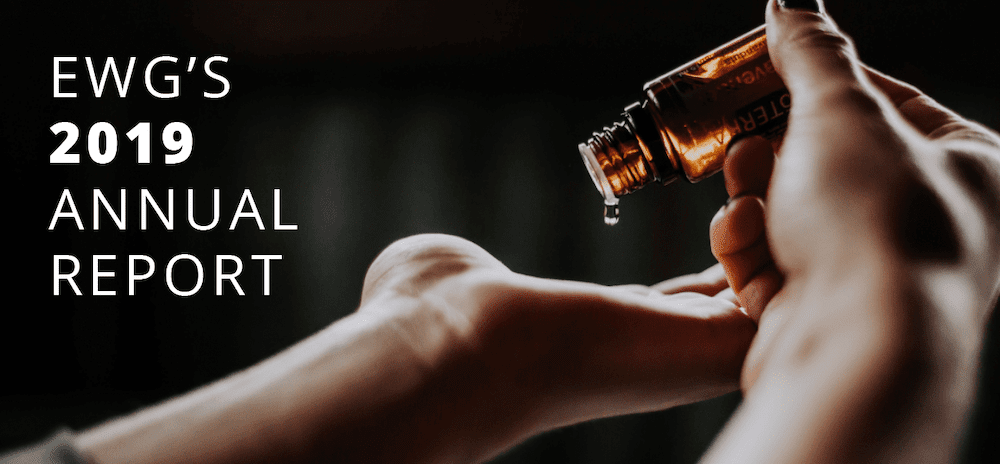
NOTE FROM KEN
2019 WAS A BANNER YEAR FOR EWG.
We saw years of work – decades, even – pay off in unprecedented ways. One of the most exciting was the warm reception our EWG VERIFIED™ program received from the personal care product industry. We saw that companies manufacturing personal care products want regulation, and in its absence, value EWG’s scientific expertise and guidance in selecting ingredients for their products. This was yet another example of how working around Washington via direct interaction with the market is often a faster route to achieving our goals.
Another bright light this year was the huge response to our glyphosate research – from our audience, the news media and the Environmental Protection Agency. Our petition to the agency to ban or restrict glyphosate on food resulted in a renewed review of the chemical and formal request for feedback from the public. We are still in the thick of the fight against glyphosate, but thanks to the widespread response to our work and growing mainstream awareness about the chemical’s health risks, we see the potential for environmental health to prevail over the Goliath chemical industry. Quite frankly, it is a once-in-a-generation opportunity.
THANK YOU FOR MAKING THIS POSSIBLE,

IN 2019
- EWG released the updated Tap Water Database, with drinking water utility data for all 50 states and a website revamped to be more user-friendly.
- We published seven major research reports, translating the science of environmental exposures for EWG’s audience of consumer citizens.
- We launched a series of new laboratory testing projects to support and enhance our research into priority chemicals.
- We published five peer-reviewed research papers analyzing nitrate pollution, cumulative cancer risks from drinking water contaminants and national drinking water quality.
- We set health-protective standards for four priority chemicals in food and water: atrazine, glyphosate, nitrate and the fluorinated “forever chemicals” called PFAS.
- We expanded the EWG VERIFIED™ program into the area of household cleaning products and put its mark on hundreds of new VERIFIED baby and personal care products.

- We saw the first mainstream EWG VERIFIED products (Herbal Essences shampoos from Procter & Gamble) and EWG VERIFIED fragrance (from Henry Rose) come to market.
- We grew the Reviewed for Science consulting program from one major corporation to four (including Revlon and Procter & Gamble), and the team is consulting with CVS, Walmart and Target to help the retailers select cleaner products.
- EWG successfully raised awareness about agriculture’s impact on drinking water during the farm bill renewal, resulting in several promising provisions in the final bill.
- Several state and national bills were introduced to improve regulation of the toxic priority chemicals PFAS and glyphosate.
- Major cosmetics reform, the Personal Care Products Safety Act, was reintroduced in the Senate.
- Following the intense consumer and media response to our glyphosate research, which exposed dangerous levels of glyphosate residue on common oat cereals like Cheerios, the EPA opened a public comment period on its draft ecological and human health risk assessments of the chemical.
- Thanks to EWG’s research and mapping of extensive PFAS contamination in drinking water across the country, and our outreach on Capitol Hill, the House and Senate both passed defense spending bills with provisions to monitor and clean up PFAS pollution – now in committee as part of the annual National Defense Authorization Act for 2020.
- EWG’s supporters made their voices heard, resulting in 1.3 million petition signatures and letters to Congress and EPA supporting reform of cosmetics, sunscreen, glyphosate, chlorpyrifos and PFAS regulation.

- EWG’s websites were visited more than 21 million times by 13 million people – an increase of 2.6 percent over 2018.
- Our total social media following increased by 12 percent in 2019, to 960,524 followers across all platforms.
- EWG’s work was mentioned 39,700 times in print, online and broadcast news media. That’s nearly twice as much coverage as organizations with budgets and staffing 10 times our size.
- This earned media is estimated to be worth $59.5 million in free exposure.
- Our work featured by print and broadcast media reached 236.2 million people.
- We were quoted or mentioned 47 times by the three most prestigious newspapers: The New York Times, The Washington Post and The Wall Street Journal.
BIG WINS
GLYPHOSATE RESEARCH AND RESPONSE
In August 2018, EWG released a new kind of pesticide report, the results of testing oat food products like cereal, oatmeal, granola and snack bars for glyphosate residues. The findings – that these popular children’s foods are tainted by a hefty dose of the weedkilling poison – resulted in a huge media response and the largest web traffic spike in EWG’s history.
We jumped on this interest, releasing a series of follow-up research reports in 2019, with action campaigns and events throughout the year, all of which resulted in significant coverage and website traffic. The articles about glyphosate in Cheerios, for example, are still the top-viewed articles on EWG’s Children’s Health website a year after their release. Our petition to lower the EPA’s limit for glyphosate in oats and stop the use of the chemical just before harvest also got traction: It was signed by 17 food companies and resulted in the agency’s taking the issue under review and formally requesting feedback from the public on the topic.
To take advantage of this rare opportunity to encourage action by the EPA, we created a second petition demanding that the agency keep the cancer-linked chemical away from our food, parks and schools. We urged the agency to listen to independent research – not Monsanto’s propaganda – and take action to protect Americans from glyphosate's carcinogenic risks. As a result of this pressure, the EPA opened a public comment period on its draft ecological and human health risk assessments of the chemical.

This summer, we also petitioned the Centers for Disease Control and Prevention to add glyphosate to its national biomonitoring program. The EPA’s dietary risk assessments indicate that children one to two years old likely have the highest glyphosate exposure levels, comparable with EPA estimates of exposure in occupational settings. Yet real-life data on infants’ and children’s exposure to glyphosate are missing. A national biomonitoring effort will give epidemiologists the opportunity to study the health effects associated with glyphosate exposure.
DOCUMENTING AGRICULTURAL POLLUTION IN LIVING COLOR
Our strategy for curbing farming runoff is to give direct technical and media support to partners working to spur action in key states in the western Lake Erie basin and the upper Midwest. To accomplish this, we have harnessed the power of compelling research and analysis, visuals and communications to highlight the role of farming in the epidemic of toxic algae outbreaks across the country and the threats they pose to health and quality of life through contaminated drinking and recreational water.
Perhaps the best example of our success with this coupled strategy is our investigative report on the Maumee River watershed, released in partnership with the Environmental Law & Policy Center, in April 2019.
By analyzing aerial photos, satellite imagery and state permit data, we found that unregulated animal factory farms are funneling chemicals in fertilizer and manure into Lake Erie, feeding the enormous toxic algae outbreak that grows there each summer. We identified 775 hog, cattle, dairy and poultry operations in the Maumee River watershed in Ohio, Indiana and Michigan in 2018 – a 40 percent increase since 2005. The investigation found that more than a fourth of factory farms in the watershed had expanded since they were built, and at least half the manure generated along the Ohio portion of the river comes from operations that lack state permits.
Because of the state’s lack of regulation, the number and size of industrial animal farms operating in the Maumee River watershed was previously undocumented, which left policymakers uninformed when facing decisions about factory farms and the pollution they create. This report provided the first-ever accounting of these operations.
The report was covered in local and national media, including editorials in The Plain Dealer of Cleveland, The Columbus Dispatch and The Toledo Blade.
MOVEMENT TOWARD NATIONAL PFAS LEGISLATION
Because of increased concern about per- and polyfluoroalkyl chemicals, or PFAS, over the past several years, these “forever chemicals” have become one of EWG’s primary priorities, with projects planned and underway across the organization, from research to government affairs to communications.
In 2019 we updated our PFAS contamination map (now at 1,361 sites of contamination in 49 states, in drinking water systems serving more than 20 million people) and released EWG’s health-based limit for PFAS in drinking water, 70 times lower than the EPA’s drinking water advisory levels for the two most notorious chemicals in the class, PFOA and PFOS. Our standards were set at levels designed to fully protect the health of children and other especially vulnerable populations.

The good news is that PFAS are getting a lot of attention on Capitol Hill, with more than 20 bills introduced in 2019, addressing issues that range from expanding monitoring to ending the use of PFAS and pushing the EPA to clean up its pollution.
EWG’s important role in this legislative push is evident in the fact that every conversation and meeting about PFAS that EWG has attended on Capitol Hill recently begins with a presentation of our map showing the extent of the problem and known sources of PFAS in drinking water. EWG’s deep understanding of PFAS pollution data and our capacity to translate that information into actionable and compelling visuals are what has turned a once little-known and unregulated chemical into the subject of one of the most important tap water protection conversations in the country.
We are excited to report that in June the Senate passed a defense spending bill that included a bipartisan amendment to dramatically expand efforts to monitor the scope of the PFAS contamination crisis and eliminate a major source of the contamination. The next month, the House passed its own version of the bill, which includes EWG-backed amendments requiring the Defense Department and the EPA to monitor and clean up the toxic chemicals. As of this writing, these bills are at an impasse, which in a way is good news, as it gives us an opportunity to continue to hammer away at the issue and build an irrefutable case for the necessity of PFAS regulation and cleanup.
We will continue to build on the current media and legislative interest in PFAS contamination to push Congress and the EPA to begin tracking and limiting its presence in finished drinking water, and restricting its use, in the future, in food and industrial products that make their way into our water and bodies.
EWG VERIFIED™ IS A (MARKET) FORCE TO RECKON WITH
EWG VERIFIED™ and Reviewed for Science, our in-house programs to disrupt consumer product markets through direct relationships with manufacturers, exploded in 2019, becoming huge players in three product markets that directly affect human health – baby care, personal care and household cleaning.
The new Reviewed for Science program gives EWG’s researchers unprecedented access to the inner workings of major manufacturers as they formulate products. Instead of pushing them to remove chemicals of concern after products are made and on the market (as we did with Johnson & Johnson in 2014, when the company removed formaldehyde from its baby care products), which takes considerable time and consumer pressure, now we are invited into the conversation to formulate safer products from the ground up. EWG’s researchers are asked for their expertise in selecting safer ingredients, expertise these manufacturers do not have internally. It is a huge honor to have our work and institutional knowledge get this respect, and the program has the potential to pave the way for a large body of personal care, baby and household cleaning products from major manufacturers that are made to EWG VERIFIED standards.
The first mainstream products verified by EWG, two Herbal Essences shampoos from Procter & Gamble, hit store shelves in 2019. We also signed non-disclosure agreements with three more major U.S. consumer goods companies to advise them in their creation of safer, cleaner products. Thanks to these advances, we expect to see EWG’s verification seal on many major brands across America within the next five years.
Here’s what two VERIFIED companies – natural segment giant EO and Procter & Gamble – say about the program:
- “As the marketplace has evolved, our customers want access to real and unbiased information about what they put on their bodies. In our view, EWG provides the most accessible, comprehensive, and scientifically reviewed information to consumers so they can make informed choices. We are proud to partner with the EWG to help cultivate a more accountable marketplace.” Susan Griffin-Black, EO Products Co-Founder and Co-CEO
- “EWG VERIFIED™ is a simple way to know all the ingredients that go into your product have been vetted for safety, meeting strict standards backed by science.” Rachel Zipperian, Herbal Essences Senior Scientist

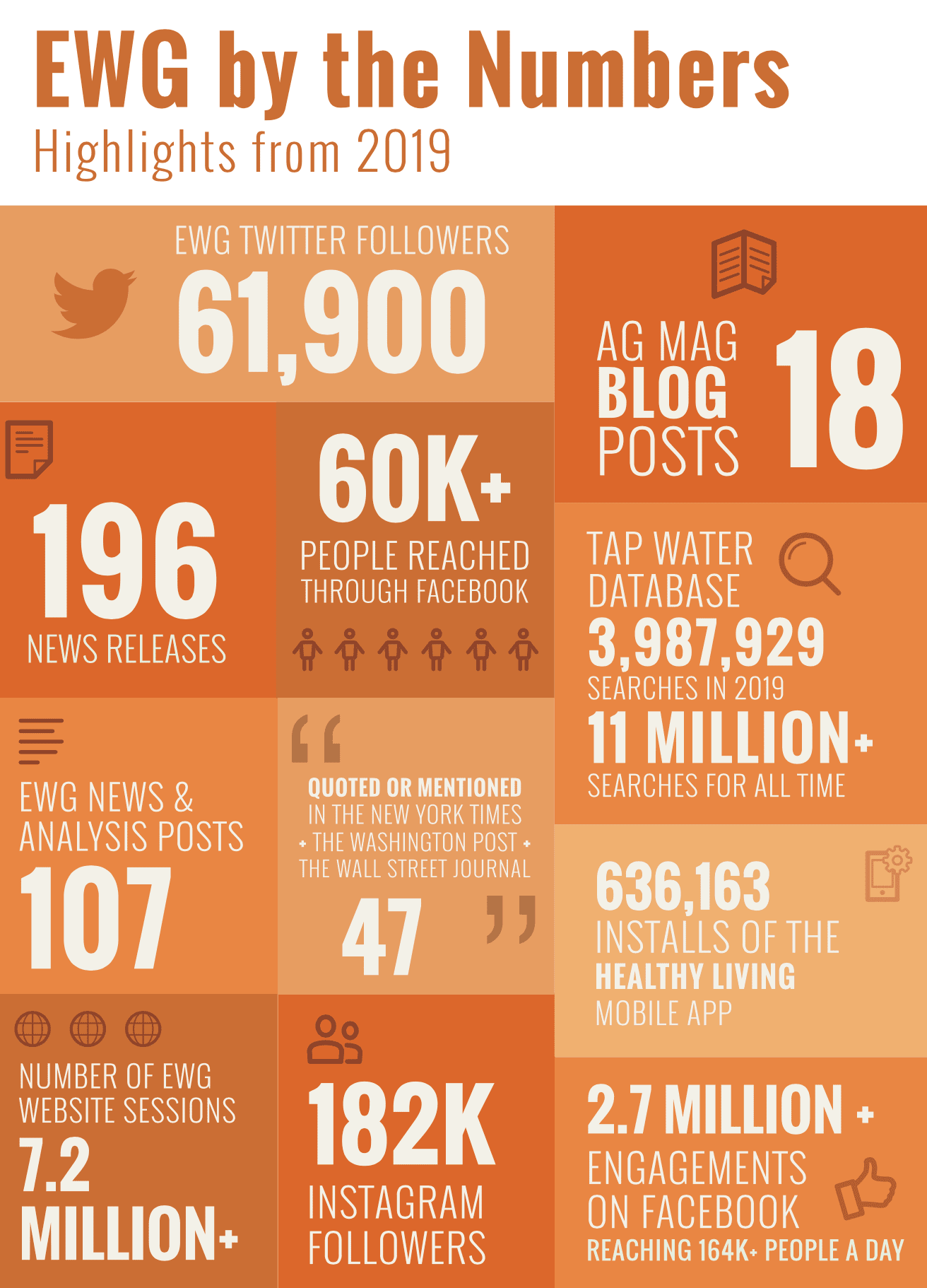
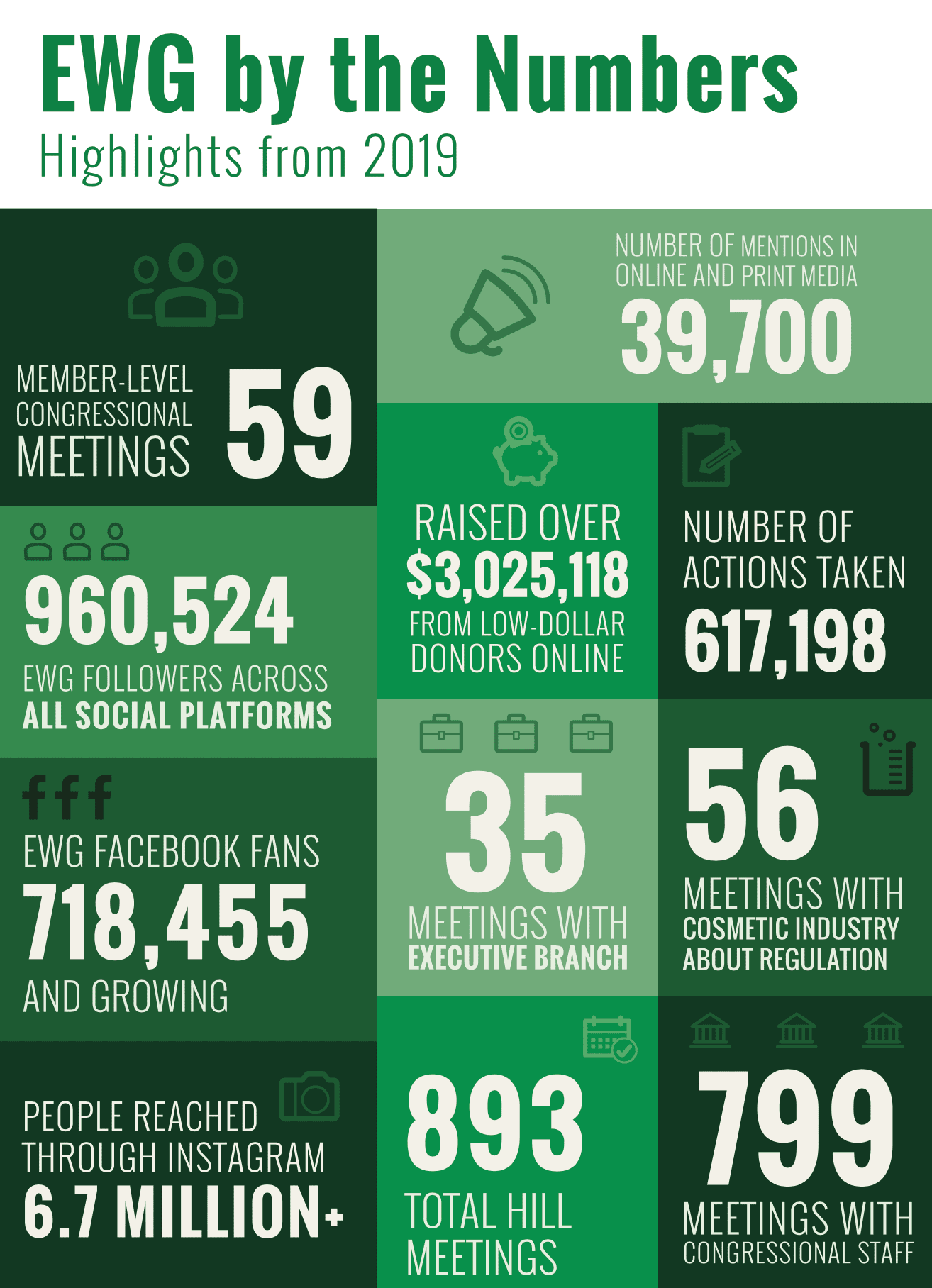
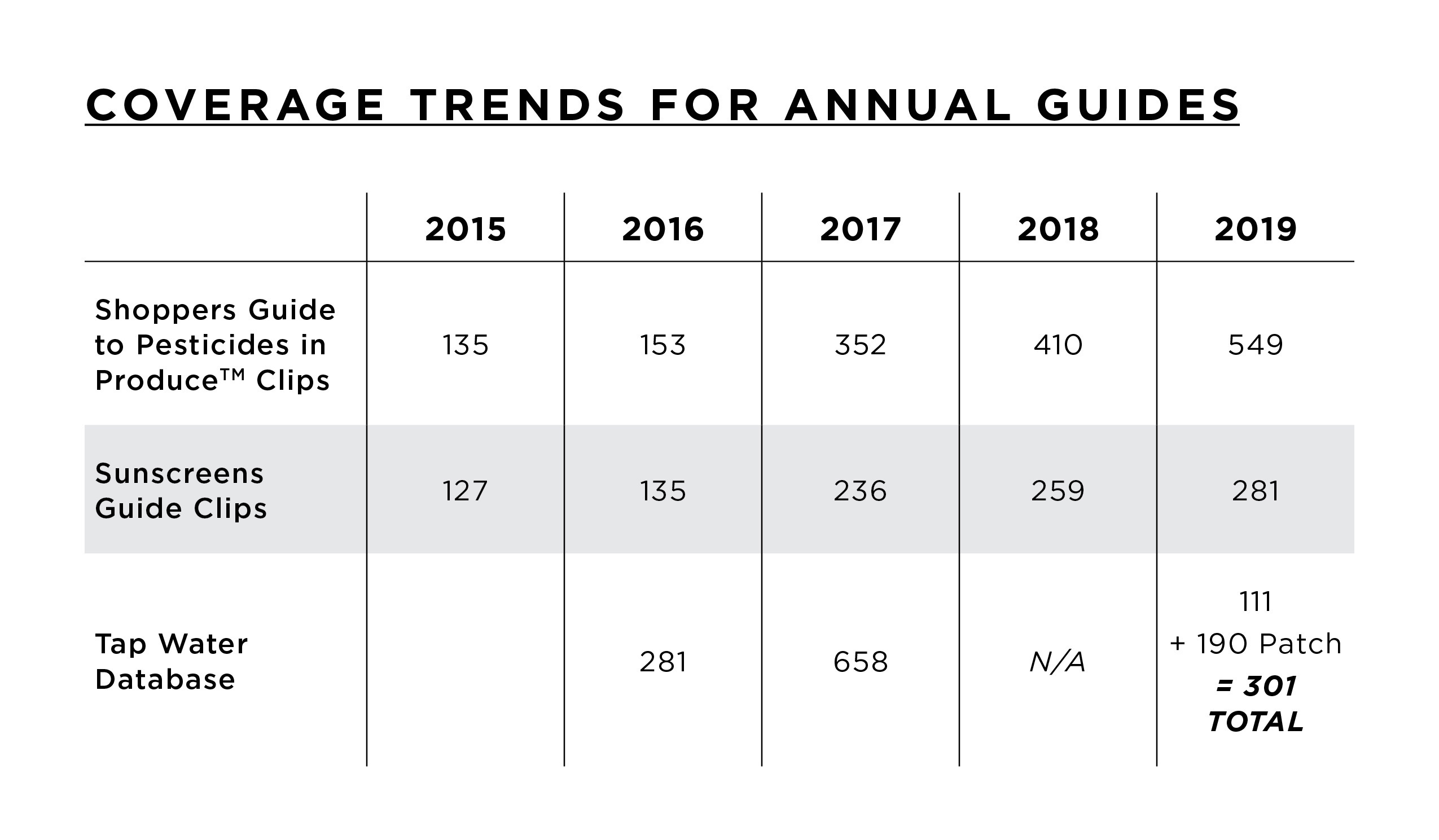
2019 RESEARCH
For 25 years, EWG has fought to protect human health and the environment. We fight to protect people from toxic chemical exposures that can cause grievous harm and threaten the health of the next generation. We fight to protect watersheds and water quality from the irrevocable damage caused by irresponsible agricultural practices and protect drinking water and food sources from contamination. We wage these fights with original, breakthrough research and consumer education tools that translate complex environmental health concerns into urgent, personal, actionable information, and we recruit millions of people every year to join us in our efforts to drive meaningful market and policy change for long-term results.
In 2019 we focused on two primary program areas:
- Science: working to protect vulnerable populations from toxic chemicals by putting information into the hands of the consumer, influencing markets to support cleaner, greener products and working to reform the law to better protect human health.
- Agriculture conservation: advancing farming systems that improve public health and the quality of life for urban and rural residents across the U.S. With our trusted research and innovative tools, we work to reform public and private policy and programs at local, state and federal levels by broadening public awareness, media engagement and online attention to the adverse impacts of current agriculture policies and farming systems while building confidence that workable solutions are available.
SCIENCE PROGRAM
MAJOR RELEASES
TAP WATER DATABASE UPDATE
In 2019 we released a full update to the Tap Water Database, with water quality data from 48,000 utilities in all 50 states. The database now incorporates several new components, including integration with our new health-based limit for nitrate in drinking water, a redesigned website with improvements resulting from user experience tests, a streamlined water filter guide with user experience upgrades, improved options for taking action after users view their local water results, and a refresh of the Farming and Tap Water section of the website, using the new data and more recent news stories about agriculture’s impact on drinking water.
The launch of the database was covered by hundreds of outlets, including Yahoo! and Newsweek, local outlets around the country – from L.A. to Boston, and Cleveland to Baton Rouge – using the database to highlight contaminants in their community water.
Using the new data, EWG researchers also completed several analysis and mapping reports on water contaminants, which helped EWG make water contamination a local, personal and tangible issue. These are:
- “Mapping PFAS Chemical Contamination at 106 U.S. Military Sites” – March 2019
- “Mapping the PFAS Contamination Crisis” – May 2019
- Algae bloom tracking map and reporting – ongoing

EWG STANDARDS
We successfully researched and released EWG health-based standards for four priority chemicals: glyphosate, atrazine, PFAS and nitrate. We also set standards for two new consumer product categories in the EWG VERIFIED program: baby and children’s personal care products, and consumer cleaning products.
- Glyphosate, the agricultural pesticide and carcinogen commonly known as Roundup, found on many children’s oat-based foods.
Using a cancer risk assessment for glyphosate developed by California state scientists, and including additional safety factors supported by the federal Food Quality Protection Act, or FQPA, EWG calculated a health benchmark for the total amount of glyphosate a child might safely ingest in a day, at 0.01 milligrams per day, significantly lower than the EPA’s dietary exposure limit.
- Atrazine, a hormone-disrupting weedkiller and tap water pollutant.
EWG scientists used the latest epidemiological data to define a health-protective benchmark specific to pregnancy, when the developing fetus is most vulnerable to the effects of hormone-disrupting chemicals. Our calculations started with an atrazine concentration of 1 ppb, a level associated with a greater risk of preterm delivery, and included an additional tenfold safety factor supported by the FQPA. This approach results in a concentration of no more than 0.1 ppb for atrazine, simazine or related triazine chemicals. This health benchmark is 30 times lower than the federal limit for atrazine and 40 times lower than the limit for simazine.
- PFAS, a pervasive industrial tap water pollutant and hormone disruptor.
Drawing on the best available science and emerging evidence of harm from the entire class of these chemicals, EWG is proposing drinking water and cleanup standards for all PFAS chemicals as a group. To fully protect the health of children and other especially vulnerable populations, our standards are 70 times lower than the EPA’s drinking water advisory levels for the two most notorious chemicals in the class, PFOA and PFOS.
- Nitrate, an agricultural tap water pollutant linked to cancer and blue-baby syndrome.
Over the past decade, a number of peer-reviewed epidemiological studies, including research conducted by the National Cancer Institute, have connected nitrate in drinking water with increased risk of colon, kidney, ovarian, thyroid and bladder cancers. This year, EWG scientists analyzed cancer rates in areas with nitrate-contaminated tap water to establish our own tap water limit for the contaminant. Based on this analysis, EWG’s scientists estimated that the level at which no adverse health effects would occur from nitrate in drinking water is 0.14 parts per million. That level, which is 70 times lower than the EPA’s legal limit, represents a one-in-a-million risk of cancer.
PEER-REVIEWED RESEARCH
Thanks to the underlying data in the Tap Water Database, we were able to commit sufficient resources to a renewed effort to conduct peer-reviewed research of drinking water pollution. Publication of peer-reviewed research significantly boosts EWG’s authority in the scientific community and, subsequently, the power of our voice among consumer citizens, the media and on Capitol Hill. Our published papers this year were:
- Environmental Justice and Drinking Water Quality: Are There Socioeconomic Disparities in Nitrate Levels in U.S. Drinking Water? – Environmental Health, January 2019
- Applying a Cumulative Risk Framework to Drinking Water Assessment: A Commentary – Environmental Health, April 2019
- California Drinking Water: How the Combination of Multiple Contaminants Raises Cancer Risks – April 2019
- Exposure-Based Assessment and Economic Valuation of Adverse Birth Outcomes and Cancer Risk Due to Nitrate in United States Drinking Water – Environmental Research, June 2019
- Cumulative Risk Analysis of Carcinogenic Contaminants in United States Drinking Water – Heliyon, September 2019
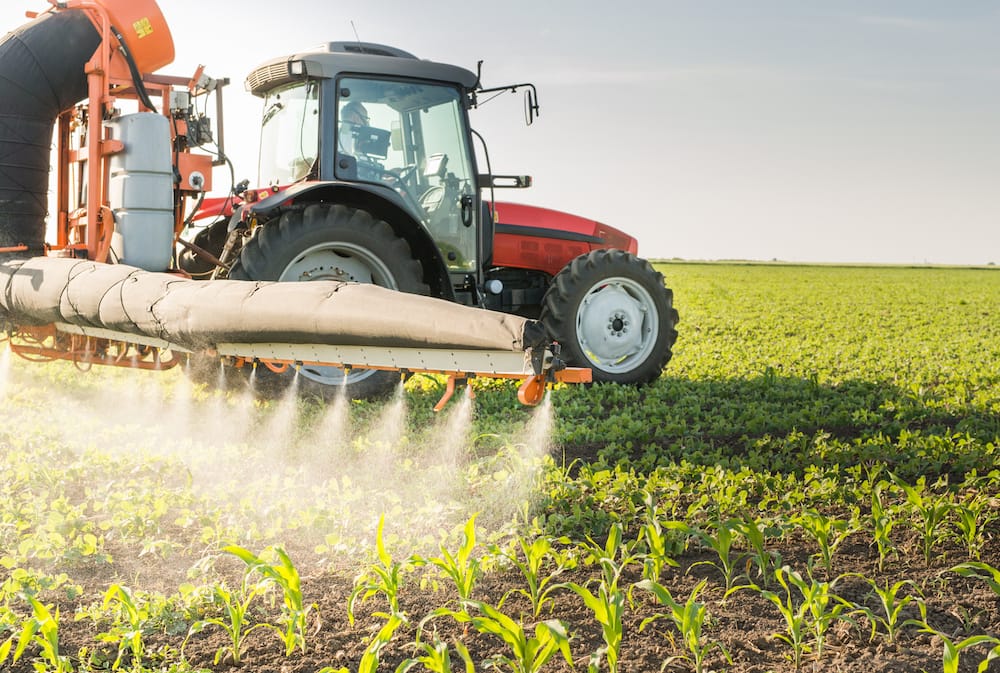
CONSUMER EDUCATION REPORTS
EWG’s Science teams completed seven research reports this period, translating the science of environmental exposures into actionable information for a lay audience of consumer citizens. These include:
- Organic: The Original Clean Food – March 2019
- More Than Half of Kale Samples Tainted by Possibly Cancer-Causing Pesticide – March 2019
- 2019 Shopper’s Guide to Pesticides in Produce™ – March 2019
- Mapping the PFAS Contamination Crisis – May 2019
- EWG Guide to Sunscreens – May 2019
- In New Round of Tests, Monsanto’s Weedkiller Still Contaminates Food Marketed to Children – June 2019
PRIORITY CHEMICALS CAMPAIGNS
We continued our ongoing campaigns against health-harming pesticides and drinking water contaminants; published major research reports on PFAS, atrazine and nitrate, including setting EWG’s health-protective standards for these harmful contaminants; continued our digital communications campaigns to fight for better regulation; and took advantage of media attention on glyphosate and PFAS to push for legislative action.
TOP PRIORITIES: PFAS AND GLYPHOSATE
This year we saw opportunities for major regulatory change for two priority chemicals: glyphosate and PFAS. These opportunities emerged from a combination of an emerging social awareness of these chemicals, our own research and reports, and subsequently, interest from lawmakers and regulatory agencies. Once we saw this, our teams quickly pivoted to make these two chemicals our organizational priorities for the year.
Glyphosate made its way onto the public stage following many successful civil lawsuits against its manufacturer – Monsanto, now Bayer – in 2018 and huge financial payouts reported by the media, followed closely by EWG’s oat testing research and its large media response. This public awareness opened an opportunity to push heavily both on the food companies that use glyphosate-treated oats and on the EPA. EWG held a lobby day in Washington, D.C., to educate lawmakers and their staff about the current science on glyphosate and collected hundreds of thousands of petition signatures to deliver to food manufacturers and the EPA.
Interest in PFAS heated up following the release of the documentary “The Devil We Know,” which tells the compelling – and devastating – story of PFAS pollution in West Virginia. We jumped on this interest by releasing updated mapping and data analysis of U.S. water systems and military bases with elevated PFAS levels and by holding an EWG lobby day, with a screening of the documentary and panel discussion on Capitol Hill, as well as screenings and education events in several cities throughout the spring and summer.
Our campaigns against both chemicals will continue, as potential legislation on PFAS and regulation by the EPA of glyphosate are considered. Our priority will be to push these issues forward in 2020, striking while the iron is hot by using science, communications and education on Capitol Hill.
CONSERVATION PROGRAM
Private Well Testing Data – October 2019
We completed collection of private well testing data from 16 states and the Chesapeake Bay region. As expected, the states’ data vary dramatically in terms of detail, types of locations and number of years of testing. The data from Iowa and Nebraska are far more robust. We decided to focus on Iowa for a new partnership to spur action in that state.
Iowa’s Private Wells Contaminated by Nitrate and Bacteria – April 2019
EWG and the Iowa Environmental Council partnered to analyze Iowa state records of private wells from 2002 to 2017 and found that thousands in Iowa are contaminated with unsafe levels of two agricultural contaminants: nitrate and bacteria, including fecal coliforms like E. Coli. Both contaminants commonly enter waterways and groundwater in runoff from farms, and both are linked to severe human health problems, including cancer and birth defects.

Cyanotoxin Test Data and Mapping – August 2019
We assembled all known tests for cyanotoxins from the National Lake Survey, as well as a handful of states that disclose test results. Microcystin was detected in all contiguous 48 states, and results from the national survey suggest detections had worsened between 2007 and 2012. After EWG completed its survey, the EPA revised its recreational or swimming advisory in May 2019, lowering by half the recommended swimming advisory level to 8 micrograms per cubic liter.
Under the Radar Report – February 2019
EWG’s GIS experts used satellite imagery to highlight the expansion of poultry operations in North Carolina, which had largely been overlooked, because the state does not require permits for them. We showed that poultry operations are now a larger source of pollution than swine operations and dramatically add to the already severe pollution problems caused by hog farms. The report was co-branded with North Carolina Waterkeepers Alliance. They and others used our new information in their advocacy to strengthen the general permit standards in the state.
Maumee River Manure Pollution Report – April 2019
This analysis examines the role of manure from animal feeding operations in triggering the annual toxic algae outbreak in Lake Erie. We used satellite and aerial imagery to document the dramatic expansion of animal feeding operations and manure production in the Maumee River watershed – the single largest contributor of phosphorus pollution that triggers outbreaks – since 2005. We documented the fact that more than half of the manure and phosphorus comes from operations that are not required to have permits. The report – co-branded with the Environmental Law and Policy Center – is being used to push for stronger regulation of animal feeding operations in Ohio.
COMMUNICATIONS AND DIGITAL
MEDIA
EWG’s work was covered more than 39,700 times by print, online, TV and radio news outlets worldwide – including The Washington Post (in 26 stories), The New York Times (16 stories) and The Wall Street Journal (five stories). This level of coverage is more than twice what similar environmental organizations with staffing and budgets 10 times the size of EWG are receiving annually. This coverage has an estimated value of $59.5 million. The estimated audience reach of just the print and broadcast coverage is 236.3 million people.
Major media moments in 2019:
- We relaunched the Tap Water Database with data through 2017, garnering extensive local and national media coverage.
- EWG was regularly mentioned in media reports on the malfeasance of the Trump administration and its ongoing attacks on environmental regulation and public health protections.
- We continued to be the go-to resource for reporters writing about the Trump administration’s farmer bailout and farm subsidies at the national and state levels.
- EWG generated robust media coverage of a peer-reviewed paper on the cumulative cancer risk of contaminants in tap water.
- We continued to serve as a resource for reporters covering glyphosate.

SOCIAL MEDIA
Our total social media following increased by 12 percent in 2019, with Instagram showing the highest rate of growth, at 78 percent. We were able to drive more than 3 million engagements across our social media profiles and increase the social traffic generated by our profiles by 6 percent.
- 960,524 EWG followers across all social media platforms
- 718,455 Facebook fans and growing
- 182,000 Instagram followers
- 61,900 Twitter followers
- 164,000 people reached per day on Facebook
- 2.7 million engagements on Facebook
- 6.7 million people reached through Instagram
IN THE NEWS
NOTABLE 2019 NEWS HEADLINES FEATURING EWG
The New York Times: (2/1/2019) Are ‘Natural Flavors’ Really Natural?
Time: (2/7/2019) Key West Is Banning Sunscreens Containing Two Common Chemicals to Protect the Great Florida Reef
The New York Times: (2/9/2019) Do You Know What’s in Your Cosmetics?
The Associated Press: (2/14/2019) EPA Too Slow on Limiting Toxic Chemicals, Critics Say
CBS News: (3/21/2019) Kale Added to Annual List of Fruits and Veggies With Most Pesticides
Forbes: (4/8/2019) Michelle Pfeiffer Launches Henry Rose, A Transparent Fragrance Brand
CBS News: (5/7/2019) New Study Claims 43 States Expose Millions to Dangerous Chemical in Drinking Water
TIME: (5/22/2019) Here Are the Safest and Most Effective Sunscreens
CNN: (6/3/2019) FDA Confirms PFAS Chemicals Are in the US Food Supply
CBS News: (6/14/2019) Bayer, Owner of Roundup, To Invest $5.6 Billion in New Weed-Killing Methods
Inside Climate News (6/26/2019): Algae Blooms Fed By Farm Flooding Add to Midwest’s Climate Woes
Chicago Sun Times: (7/3/2019) Sunscreen Protects the Skin, but Does It Harm the Body?
The New Food Economy (7/9/2019): Another Summer, Another Run of Toxic Algae Blooms
Quartz (7/13/2019): Tropical Storm Barry Could Make a Bad Algae Bloom Worse
Reuters: (7/30/2019) Bulk of Trump's U.S. Farm Aid Goes to Biggest and Wealthiest Farmers: Advocacy Group
Bloomberg (7/30/2019): Majority of Trump’s Trade Aid Went to Biggest Farms, Study Finds
The Washington Post (7/31/2019): Trump’s $16 billion farm bailout will make rich farmers richer, report says
The Washington Post (7/31/2019): “Midwest” Is Not Synonymous With “Rural and White”
The Wall Street Journal: (8/2/2019) Sunscreen Protects the Skin, but Does It Harm the Body?
UPI (8/7/2019): Gulf of Mexico’s Dead Zone Expected To Grow
The New Republic (8/28/2019): The Frightening Spread of Toxic Algae
Bloomberg: (9/5/2019) Hog Waste Fears Raised Again as Dorian Approaches North Carolina
The New York Times: (9/6/2019) Do D.I.Y. Cleaners Really Work?
The Associated Press: (9/25/2019) Report Details Water Contamination in California, Listing Chemical Linked to Health Issues
Pacific Standard: (10/2/19) The Cost of Cleaning up Nitrate Contamination Falls on America's Poorest Counties
Los Angeles Times: (10/8/19) Firefighting Foam Leaves Toxic Legacy in Californians’ Drinking Water
Yahoo!: (10/23/19) How Safe Is Your Tap Water? This Database Can Tell You
PBS NewsHour: (10/29/19) Even If Your Drinking Water Gets a ‘Passing Grade,’ It May Not Be Safe
Bloomberg: (11/12/19) Democrats Blast Trump Trade Aid as Favoring Southern Farmers
NBC: (12/16/19) A 'Forever Chemical' Contaminates Drinking Water Near Military Bases
The Washington Post: (12/26/19) In Trump County, a Season of Need on Family Farms
FINANCIALS
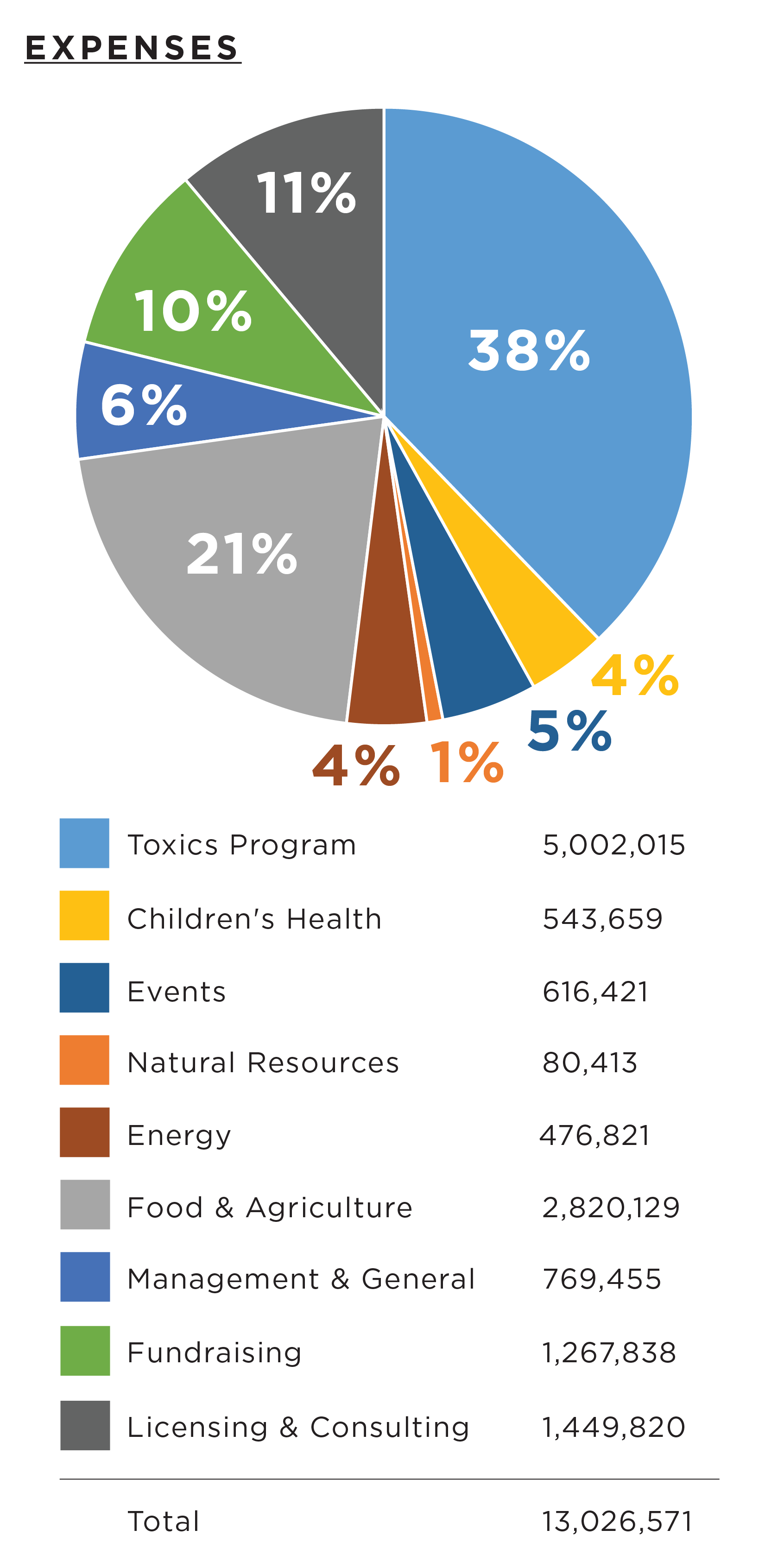
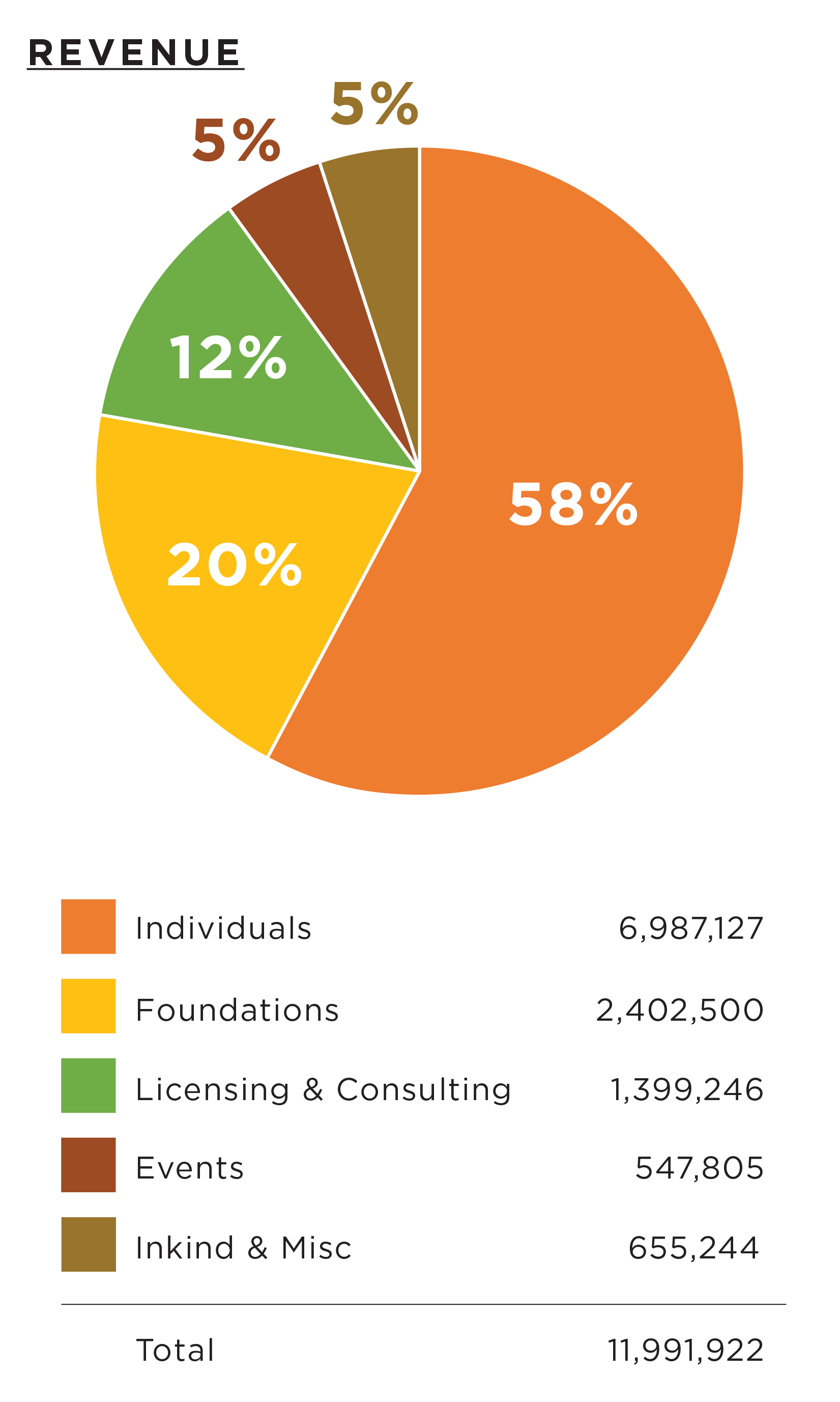
Ending Net Assets at December 31, 2019: $10,003,520
BOARD OF DIRECTORS
- David Baker
- Suzan Bymel
- Ken Cook
- Rob Fetherstonhaugh
- Christine Gardner
- Meg Hirshberg
- Mark Hyman, MD
- Dr. Bojana Jankovic Weatherly
- Dr. Harvey Karp
- Nina Montée Karp
- C.J. Kettler
- Karen Malkin
- Elise Museles
- Randy Paynter
- Michelle Pfeiffer
- Drummond Pike, Secretary & Treasurer
- Serena Torrey Roosevelt
- Bill Ross, Vice Chair
- Kim Rozenfeld
- Laura Turner Seydel
- Shazi Visram
